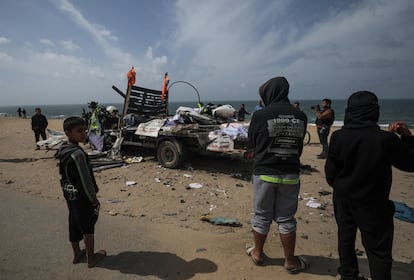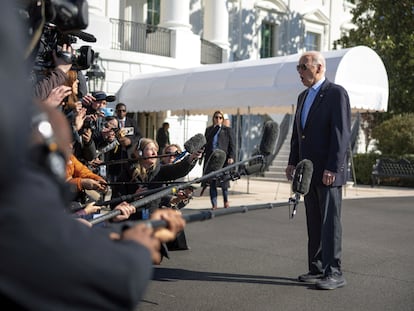Hunger, hostages and the rapidly approaching Ramadan holiday shape the negotiations on a ceasefire in Gaza
Talks resume in Cairo, and the issue of hostages is the main stumbling block. According to Hamas, 15 children have now died of starvation or dehydration in the Gaza Strip

There is increasing international pressure for Israel and Hamas to reach a ceasefire. The hunger spreading among the population in the Gaza Strip, which was evident on Thursday in the tragic events that killed over 100 as they were seeking humanitarian aid; the rapidly approaching Ramadan, an important holiday in the Muslim world; and the demands of the families of the Israeli hostages who remain captive are shaping the negotiations that resumed in Cairo this Sunday without an Israeli presence.
But there has been contact among the parties for weeks in ongoing negotiations without reaching an agreement yet. The mediating countries — which include Egypt, Qatar and the United States — have been working on a ceasefire proposal for about six weeks. However, the hostage issue remains an obstacle to progress.
Israel says that it is waiting for Hamas to report the identities of the hostages that it is willing to release, those already dead in Gaza and the number of Palestinians imprisoned in Israeli that jails it wants in exchange for each hostage. “Hamas refuses to give clear answers and therefore there is no reason to send the Israeli delegation” to the Egyptian capital, the Israeli daily Yedioth Ahronoth reported. For its part, Hamas continues to demand the withdrawal of Israel’s occupation troops, freedom of movement for citizens in the Gaza Strip and allowing displaced persons to return to their homes.
On Saturday evening, thousands of people arrived in Jerusalem after a four-day march from the Gaza border to pressure Prime Minister Benjamin Netanyahu to reach a ceasefire agreement that would open the door to freeing over 100 hostages who remain captive in the Gaza Strip after nearly five months of war. In a country that has become a real pressure cooker, this is just one of the unresolved issues in the shadow of the conflict that began on October 7 when Palestinian Islamists massacred some 1,200 people and took around 240 hostages.
There is still hope for the negotiations for a six-week ceasefire, which would be longer than the only cessation of hostilities achieved so far: a weeklong pause at the end of November. That would facilitate the entry of more aid into Gaza, as well as the exchange of hostages for prisoners. “We have lost four family members, and we don’t want the fifth to come back in a coffin,” Sharon Sharabi said at the event held by the families at the end of the march in Jerusalem’s Paris Square, near the prime minister’s residence. The 134 hostages remaining in Gaza include Israeli military men and women, children, women, the elderly, the wounded and at least thirty dead.
A U.S. official, quoted by Reuters, said Saturday, “The path to a ceasefire at this point is clear. There is a framework agreement on the table that Israel has accepted. It is now up to Hamas to respond.” But the proposal does not appear to satisfy Hamas’ main demand for a permanent end to the war. It also leaves the fate of over half of the 100 hostages unresolved, specifically the men who do not fall into any of the categories included in the draft ceasefire agreement — women, children, the elderly and the wounded.
Egyptian mediators have suggested that these issues could be postponed to later stages of the negotiations, but a Palestinian Islamist source told Reuters that the militants are still waiting for a “comprehensive agreement.”
Starving to death
Meanwhile, the number of children starving to death in Gaza is growing due to the blockade of humanitarian aid. According to local health authorities, 15 have died in the last few days, while UNICEF puts the figure at 10 at least. “We fear for the lives of six more children suffering from malnutrition and diarrhea in the hospital’s intensive care unit as a result of the cessation of the electric generator and oxygen and the weakness of medical capabilities,” Dr. Ashraf Al-Qidra said in a statement distributed to the media on Sunday morning.
Faced with the need to deal with this crisis, Spain has announced that it will collaborate with countries airdropping aid over Gaza. The government will provide Jordan with 110 cargo parachutes that are being used to deliver material and food to the Gazan population, according to the Ministry of Defense.
Ramadan is a holy month of fasting and reflection that commemorates the revelation of the Koran to the Prophet Mohammed. The Palestinian Authority (PA) prioritizes achieving a ceasefire before the start of the holiday — a period of special sensitivity in the Muslim world — amid a Gazan population hit hard by the war. “The top priority is … a ceasefire,” even above the entry of food, Mai Al-Kaila, the Health Minister of Palestine, told Al Jazeera. The minister has been acting in an interim capacity since her entire government resigned on Monday.
The spectacular image of U.S. parachutes cutting through the Gaza sky with aid packages for the starving population clashes with the reality on the ground. Despite the 38,000 rations airdropped by the U.S. on Saturday, hundreds of thousands of people remain hungry.
The “flour massacre”
As in previous days, Israel is attempting to deny the existence of a blockade to the entry of humanitarian aid, which the U.N. and humanitarian organizations have been denouncing for months, warning of a growing famine. This Sunday, military spokesman Daniel Hagari said that they are trying to get aid to civilians because the war is against Hamas, according to a recording broadcast on X (formerly Twitter). He further insisted that Israel was not responsible for last Thursday’s so-called “flour massacre,” when Gazan authorities say 112 people were killed, during an attack as people tried to access food trucks in Gaza City.
After admitting on Thursday that the Israeli military opened fire, the army now claims that after “an initial review of the unfortunate incident, civilians were trampled to death and wounded while storming the convoy,” Hagari claimed. “Israel’s Defense Forces did not conduct an attack on any aid convoy” and “most of the Palestinians were killed or injured as a result of the stampede,” the spokesman concluded.
The Israeli army puts the number of trucks that have entered the Gaza Strip in the past five months of war at 14,000. This volume is lower than what arrived in a single month prior to October 7, when the 2.3 million inhabitants, the majority of whom are displaced, hungry, thirsty and homeless today, were not being punished by Israeli attacks.
In the past 24 hours, 90 people have been killed and 177 wounded, according to the same health source in Gaza. Thus, since October 7, 30,410 people have died in the Gaza Strip and 71,700 have been injured. The statement adds that the number of people who still cannot be rescued from the rubble of bombed buildings and those abandoned on the roads, where the Israeli occupation troops prohibit access to rescue teams, are not included in this tally.
Sign up for our weekly newsletter to get more English-language news coverage from EL PAÍS USA Edition
Tu suscripción se está usando en otro dispositivo
¿Quieres añadir otro usuario a tu suscripción?
Si continúas leyendo en este dispositivo, no se podrá leer en el otro.
FlechaTu suscripción se está usando en otro dispositivo y solo puedes acceder a EL PAÍS desde un dispositivo a la vez.
Si quieres compartir tu cuenta, cambia tu suscripción a la modalidad Premium, así podrás añadir otro usuario. Cada uno accederá con su propia cuenta de email, lo que os permitirá personalizar vuestra experiencia en EL PAÍS.
¿Tienes una suscripción de empresa? Accede aquí para contratar más cuentas.
En el caso de no saber quién está usando tu cuenta, te recomendamos cambiar tu contraseña aquí.
Si decides continuar compartiendo tu cuenta, este mensaje se mostrará en tu dispositivo y en el de la otra persona que está usando tu cuenta de forma indefinida, afectando a tu experiencia de lectura. Puedes consultar aquí los términos y condiciones de la suscripción digital.
More information
Archived In
Últimas noticias
Most viewed
- Sinaloa Cartel war is taking its toll on Los Chapitos
- Oona Chaplin: ‘I told James Cameron that I was living in a treehouse and starting a permaculture project with a friend’
- Reinhard Genzel, Nobel laureate in physics: ‘One-minute videos will never give you the truth’
- Why the price of coffee has skyrocketed: from Brazilian plantations to specialty coffee houses
- Silver prices are going crazy: This is what’s fueling the rally










































